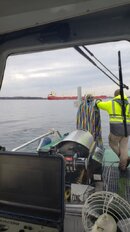1) One hose (that's how you call it?) is for the air, what about the second one?
Generally the term umbilical is used for the connection to the surface. It is generally comprised of at least three parts at a minimum.
1 - Breathing air hose, provides air (or mixed gases) to breathe
2 - Communications cable, lets you talk to the surface and other divers
3 - Strength member, makes sure it all stays together when you pull on the umbilical
The communications and strength member can be combined into a "com rope". Looks like a normal rope, but has wires inside of it.
4 - Pneumofathometer hose, an air hose connected to a calibrated gauge so the surface can actually measure your depth
5 - Power, for lights
6 - Hot water hose, used to keep you warm using hot water
7 - Video cable, so the surface can watch what you are doing.
8 - I'm sure I forgot something that is possible....
The first three are pretty much mandatory. The rest can be optional depending on what exactly you are doing.
The tank on your back is for emergency in case you somehow severed your main breathing air hose. Not a good day if you have to use it.....
I'm not a professional commercial diver, but I've done a number of surface supplied dives. Its a different experience from scuba diving. I recommend that if you ever get a chance to try, do it.
Patrick





